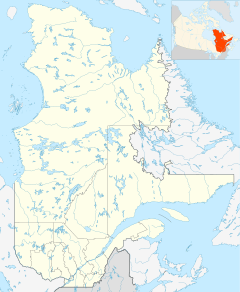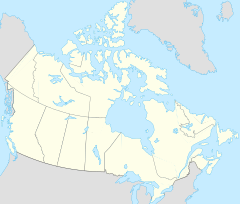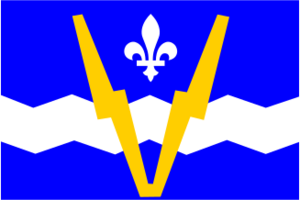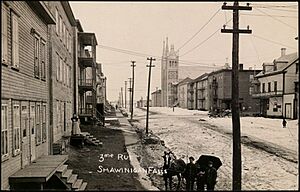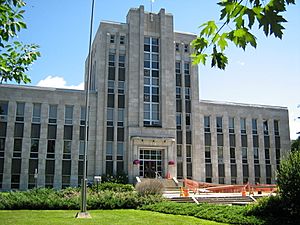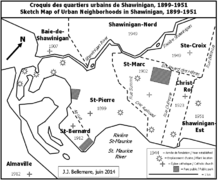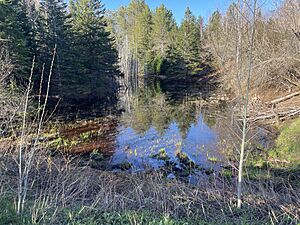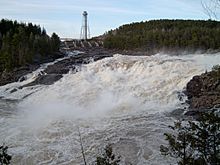Shawinigan facts for kids
Quick facts for kids
Shawinigan
|
|||
|---|---|---|---|
|
City
|
|||
| Ville de Shawinigan | |||

Aerial view of Saint-Maurice River and the city
|
|||
|
|||
| Nickname(s):
The City of Electricity
|
|||
| Motto(s):
Age Quod Agis (Do what you are doing)
|
|||
| Country | Canada | ||
| Province | Quebec | ||
| Region | Mauricie | ||
| RCM | None | ||
| Settled | 1851 | ||
| Constituted | January 1, 2002 | ||
| Area | |||
| • City | 798.80 km2 (308.42 sq mi) | ||
| • Land | 729.98 km2 (281.85 sq mi) | ||
| • Urban | 31.77 km2 (12.27 sq mi) | ||
| Population
(2021)
|
|||
| • City | 49,620 | ||
| • Density | 68/km2 (180/sq mi) | ||
| • Urban density | 1,225.4/km2 (3,174/sq mi) | ||
| • Pop 2016-2021 | |||
| • Dwellings | 27,444 | ||
| Time zone | UTC−5 (EST) | ||
| • Summer (DST) | UTC−4 (EDT) | ||
| Postal code(s) |
G9N to G9R
|
||
| Area code(s) | 819 | ||
| Highways |
|||
Shawinigan (English: /ʃəˈwɪnɪɡən/; French: [ʃawiniɡan]) is a city in Quebec, Canada. It is located on the Saint-Maurice River in the Mauricie area. In 2021, about 49,620 people lived there.
Shawinigan is also a special area in Quebec that acts like a regional county. It is the main city for the Saint-Maurice legal district. The name Shawinigan has been spelled many ways over time. It might mean "south portage," "portage of beeches," or "angular portage." Before 1958, the city was called Shawinigan Falls.
Did you know that Jean Chrétien, a former Prime Minister of Canada, was born in Shawinigan?
Contents
History of Shawinigan
In 1651, a Jesuit priest named Buteaux was the first European to travel up the Saint-Maurice River. He reached the big waterfalls here. Missionaries traveling further up the river would often stop and rest at this spot. Before Shawinigan Falls became a city, the area mainly focused on lumber and agriculture.
How Shawinigan Became a Boomtown
In the late 1890s, Shawinigan Falls caught the eye of business people. They saw that its waterfalls were perfect for making hydroelectricity. This led to the creation of the Shawinigan Water & Power Company (SW&P).
In 1899, the SW&P hired engineers to plan a new industrial town. This plan laid the groundwork for what is now Downtown Shawinigan.
In 1901, the area became the Village Municipality of Shawinigan Falls. It became a town (ville) just one year later, in 1902. The new power station helped the town grow very quickly. Shawinigan Falls achieved many "firsts" in Canadian history. It was the first place to produce aluminum (1901), carborundum (1908), and cellophane pellets (1932). It was also one of the first Canadian cities to have electric street lighting.
Growing the City: Urban Development
For many years, local industries like pulp and paper, chemical, and textile created thousands of jobs. This helped the city grow a lot.
Downtown Shawinigan Falls grew steadily. By 1921, it had many shops, homes, and apartment buildings. The city hired the Olmsted Brothers to make the city more beautiful. By the late 1920s, Downtown Shawinigan Falls had a public market, a fire station, a technical school, churches, and two parks.
Wealthier people lived in large homes on streets like Maple Street. Many of these people were part of the English-speaking community. This group once made up more than 30% of the local population.
As new factories opened to the east and north, new neighborhoods appeared. These areas often grew around new Catholic churches. The Saint-Marc area was added to the city in 1902. The Christ-Roi neighborhood was added in 1925, thanks to new plants like Canadian Carborundum. The area now known as Shawinigan-Est was added in 1932.
Uptown Shawinigan Falls had its own fire station by 1922. It also had a park and swimming pool by 1940.
Near the Shawinigan River, the Belgo pulp and paper plant attracted many residents. This led to the small community of Baie-de-Shawinigan. Across the Saint-Maurice River, Shawinigan-Sud (then called Almaville) grew as a residential area.
The Great Depression Years
The good times were interrupted by the Great Depression in the 1930s. Many factories had to slow down or stop production. This left many people without jobs. Families needed help from the government to get by. The City Council started a program to create jobs through public works projects.
One project was building a promenade along the Saint-Maurice River. This helped provide work for people during the depression.
World War II and Recovery
World War II helped Shawinigan and many other Canadian cities recover economically. During the war, the windows of local power plants were painted black. This was to protect them from possible air attacks.
The 81st Artillery Battery from Shawinigan was called to serve in World War II. Its members trained in Ontario and the United Kingdom. They helped the Allies in the Normandy Landings in 1944-45. This led to the liberation of France.
In 1948, a cenotaph (a monument for soldiers) was built in downtown Shawinigan. It is called Monument des Braves. It honors soldiers who died in World War I and World War II.
Rise of the Working Class
By the early 1950s, Shawinigan offered steady jobs and good wages. This made it a strong center for labor unions. The growing working class also led to many local taverns.
Labor Unions and Politics
As workers gained power, Shawinigan became a place where labor unions were very active. For example, workers at the Belgo pulp and paper plant went on strike in 1955. In the 1952 provincial election, Shawinigan elected a Liberal politician. This was seen as a challenge to the Premier of Quebec, Maurice Duplessis. He responded by not approving a new bridge between Shawinigan Falls and Shawinigan-Sud. The bridge was finally built after the Liberal Party won the 1960 election. It opened on September 2, 1962.
Taverns as Social Spots
In the 1950s, taverns were social places mainly for male industrial workers. Most were in Downtown Shawinigan Falls and the Saint-Marc neighborhood. Shawinigan-Sud was a "dry town" (no alcohol sales) until 1961.
In 1981, a new law allowed women into most taverns. By 1986, women were commonly admitted. Many taverns closed down as industries declined in the late 20th century.
City Changes and Decline
In the 1950s, Shawinigan Falls began to decline. New technology meant industries didn't need to be near the waterfalls as much. Many companies moved to bigger cities or closed.
In 1958, the city's name was shortened to just Shawinigan. As jobs decreased, many residents, especially English-speakers, left the area. Shawinigan High School is now the only English-language school left. The last English newspaper closed in 1970.
In 1963, the Quebec government took over eleven private electricity companies, including SW&P. This was good for the public but may have hurt local businesses.
New Focus: Tourism and Hospitality
To help the city recover, leaders started to promote tourism. A great example is La Cité de l'Énergie. This is a theme park about local industrial history. It has a 115-meter-high observation tower. Since opening in 1997, it has brought many visitors. It offers bus tours, cruises, shows, and exhibits. Since 2012, it also has a museum about former Prime Minister Jean Chrétien. It displays gifts he received during his time in office.
City Mergers and Growth
In 1998, Shawinigan merged with the Village Municipality of Baie-de-Shawinigan.
On January 1, 2002, Shawinigan joined with many other municipalities. These included:
- Grand-Mère
- Shawinigan-Sud
- Saint-Georges-de-Champlain
- Lac-à-la-Tortue
- Saint-Gérard-des-Laurentides
- Saint-Jean-des-Piles
Geography and Climate
Climate in Shawinigan
Shawinigan has a humid continental climate. This means it has cold, snowy winters and warm, humid summers. It gets a lot of rain and snow throughout the year, which is typical for Eastern Canada.
| Climate data for Shawinigan | |||||||||||||
|---|---|---|---|---|---|---|---|---|---|---|---|---|---|
| Month | Jan | Feb | Mar | Apr | May | Jun | Jul | Aug | Sep | Oct | Nov | Dec | Year |
| Record high °C (°F) | 10.5 (50.9) |
9.4 (48.9) |
17.8 (64.0) |
31.0 (87.8) |
33.9 (93.0) |
35.6 (96.1) |
36.7 (98.1) |
37.2 (99.0) |
32.8 (91.0) |
30.0 (86.0) |
19.4 (66.9) |
11.1 (52.0) |
37.2 (99.0) |
| Mean daily maximum °C (°F) | −8.0 (17.6) |
−5.2 (22.6) |
1.1 (34.0) |
9.3 (48.7) |
18.1 (64.6) |
22.8 (73.0) |
25.1 (77.2) |
23.6 (74.5) |
17.8 (64.0) |
11.1 (52.0) |
3.1 (37.6) |
−4.3 (24.3) |
9.6 (49.3) |
| Daily mean °C (°F) | −13.2 (8.2) |
−10.6 (12.9) |
−4.0 (24.8) |
4.2 (39.6) |
12.0 (53.6) |
17.1 (62.8) |
19.6 (67.3) |
18.3 (64.9) |
12.9 (55.2) |
6.8 (44.2) |
−0.4 (31.3) |
−8.7 (16.3) |
4.5 (40.1) |
| Mean daily minimum °C (°F) | −18.3 (−0.9) |
−16.0 (3.2) |
−9.2 (15.4) |
−0.9 (30.4) |
5.8 (42.4) |
11.3 (52.3) |
14.1 (57.4) |
13.0 (55.4) |
8.0 (46.4) |
2.5 (36.5) |
−4.0 (24.8) |
−13.1 (8.4) |
−0.6 (30.9) |
| Record low °C (°F) | −47.0 (−52.6) |
−37.8 (−36.0) |
−33.9 (−29.0) |
−24.4 (−11.9) |
−7.2 (19.0) |
−2.8 (27.0) |
−0.6 (30.9) |
1.0 (33.8) |
−6.7 (19.9) |
−11.1 (12.0) |
−25.0 (−13.0) |
−42.2 (−44.0) |
−47.0 (−52.6) |
| Average precipitation mm (inches) | 78.9 (3.11) |
60.1 (2.37) |
73.5 (2.89) |
81.1 (3.19) |
97.6 (3.84) |
101.6 (4.00) |
107.6 (4.24) |
103.0 (4.06) |
99.3 (3.91) |
92.5 (3.64) |
82.5 (3.25) |
91.0 (3.58) |
1,068.6 (42.07) |
| Average rainfall mm (inches) | 17.7 (0.70) |
15.0 (0.59) |
34.5 (1.36) |
67.7 (2.67) |
97.1 (3.82) |
101.6 (4.00) |
107.6 (4.24) |
103.0 (4.06) |
99.3 (3.91) |
91.9 (3.62) |
58.5 (2.30) |
25.6 (1.01) |
819.4 (32.26) |
| Average snowfall cm (inches) | 61.1 (24.1) |
45.2 (17.8) |
39.0 (15.4) |
13.4 (5.3) |
0.5 (0.2) |
0.0 (0.0) |
0.0 (0.0) |
0.0 (0.0) |
0.0 (0.0) |
0.6 (0.2) |
24.0 (9.4) |
65.4 (25.7) |
249.1 (98.1) |
| Average precipitation days (≥ 0.2 mm) | 12.4 | 9.1 | 10.0 | 11.2 | 12.5 | 13.3 | 13.3 | 13.0 | 12.6 | 11.9 | 11.1 | 13.1 | 143.4 |
| Average rainy days (≥ 0.2 mm) | 1.5 | 1.1 | 4.0 | 9.6 | 12.5 | 13.3 | 13.3 | 13.0 | 12.6 | 11.7 | 6.3 | 2.6 | 101.3 |
| Average snowy days (≥ 0.2 cm) | 11.4 | 8.0 | 6.0 | 2.1 | 0.2 | 0.0 | 0.0 | 0.0 | 0.0 | 0.3 | 4.7 | 10.7 | 43.5 |
| Source: Environment Canada | |||||||||||||
Economy and Industries
Shawinigan has been home to several important industries:
- An Alcan aluminum plant: This plant was built in 1941. It took over from an older plant built in 1901. The older plant is now part of La Cité de l'Énergie. The newer plant closed in 2015.
- The Belgo pulp and paper plant: This plant stopped making paper on February 29, 2008.
- The Laurentide Paper Company: This is the last major paper mill still active in Shawinigan. It is located in the Grand-Mère district.
- Large hydroelectric complex: The Shawinigan 2 (1911) and Shawinigan 3 (1948) power plants are here. They were built by the Shawinigan Water & Power Company. Since 1963, they have been owned by Hydro-Québec. They are also near the Saint-Maurice River.
Arts and Culture
- The Classique internationale de canots de la Mauricie: This is a famous marathon canoe race. It has been held every year since 1934.
- Grand-Mère's Fête nationale du Québec celebration: This event includes a bonfire and live music. It takes place at the Parc de la rivière Grand-Mère. Many people attend, making it one of the largest crowds in the Mauricie area. This tradition has been going on for decades.
Attractions to Visit
- The Trou du Diable (Devil's Hole): This is a mysterious swirling spot in the Saint-Maurice River near the falls. Legend says it has no bottom, making it impossible to rescue anyone who falls in.
- Parc Saint-Maurice: This park is in downtown Shawinigan. It was part of the city's original plan.
- The 62nd (Shawinigan) Field Artillery Regiment: This is a Reserve unit of the Canadian Army. It was called to active duty during World War II.
- La Cité de l'Énergie: A popular theme park about the city's industrial history.
- The Shawinigan Cataractes: This is a junior hockey team. They are the only team in the QMJHL to have stayed in the same city since the league started in 1969. They play at the Centre Gervais-Auto.
Sports in Shawinigan
The Shawinigan Cataractes are a hockey team in the Quebec Maritimes Junior Hockey League. They play their games at the Centre Gervais Auto in Shawinigan. In 2012, Shawinigan hosted the 2012 Memorial Cup hockey tournament. The Cataractes won the championship, beating the London Knights in the final game.
City Infrastructure
Transportation and Street Names
Many of Shawinigan's oldest streets have numbers, like streets in Manhattan, New York. Also, Avenue Broadway was named after the famous street in Manhattan.
Other streets and avenues were named to honor important people, such as:
Religion and Churches
In recent years, fewer Catholics in Shawinigan attend church. Because of this, the Roman Catholic Diocese of Trois-Rivières has had trouble keeping all its churches open. Some parishes have merged.
The current Saint-Pierre church building was built between 1908 and 1937. Its beautiful stained glass windows were designed by Italian Canadian artist Guido Nincheri. He worked on them from 1930 to 1961.
Education in Shawinigan
Shawinigan has several public schools. Seven of them are managed by the Commission scolaire de l'Énergie school board.
- Carrefour Formation Mauricie (Vocational education)
- Centre d'éducation des adultes du Saint-Maurice (Adult education)
- École secondaire des Chutes (Secondary school)
- Immaculée-Conception (Elementary school)
- Saint-Charles-Garnier (Elementary school)
- Saint-Jacques (Elementary school)
- Saint-Joseph (Elementary school)
Children who meet the rules for learning in English can go to Shawinigan High School. This school is run by the Central Québec School Board.
Shawinigan also has the Séminaire Sainte-Marie, which is a private high school. There is also Collège Shawinigan, which is a CEGEP (a type of college in Quebec).
Sister Cities
Shawinigan has sister cities, which means they have special friendly relationships:
Notable People from Shawinigan
Many famous people have come from Shawinigan, including:
- Marcel Pronovost (1930-2015): A National Hockey League player, mostly known for his time with the Detroit Red Wings. He was inducted into the Hockey Hall of Fame in 1978.
- Peter Blaikie: A lawyer.
- Michaël Bournival: A National Hockey League player.
- Aline Chrétien: The wife of Jean Chrétien.
- Jean Chrétien: The 20th Prime Minister of Canada from 1993-2003.
- Sylvain Cossette: A singer.
- Antoine Dufour: An acoustic guitarist.
- Paul Dumont: One of the founders of the Quebec Major Junior Hockey League.
- Louise Forestier: A singer and actress.
- Martin Gélinas: A National Hockey League player.
- Jacques Lacoursière: A historian.
- Carole Laure: An actress.
- Bryan Perro: An author, known for the Amos Daragon series.
- Jacques Plante: A National Hockey League player.
- André Pronovost: A National Hockey League player.
- Camil Samson: A political leader.
Images for kids
See also
 In Spanish: Shawinigan para niños
In Spanish: Shawinigan para niños



